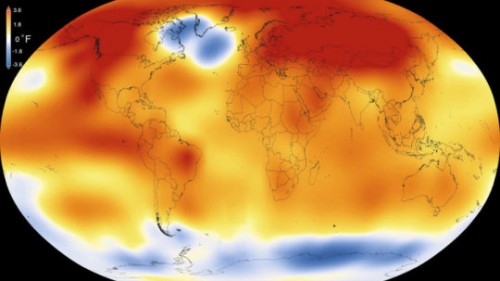Independent analyzes by NASA and the National Oceanic and Atmospheric Administration (NOAA) show that this was the hottest year since land surface temperature measurements began in 1880.

2015 was the hottest year on Earth since modern records of temperature measurements on the surface of the earth began in 1880. This is according to independent analyzes by NASA and the National Atmospheric and Oceanographic Agency - NOAA. Remember, 2014 equaled the previous record of 1998.
In 2015, the long-term warming trend continued, according to an analysis conducted by scientists at NASA's Goddard Institute for Space Research (GISS) in New York. NOAA scientists also agree with the statement that 2015 was the hottest year in history based on independent analyses.
"Climate change is the challenge of our generation, and NASA's vital work in this important area affects every person on Earth," said NASA Administrator Charles Bolden. "Today's announcement not only underscores how critical NASA's Earth observation program is. This plan is the key point for identifying which data should capture the attention of decision makers. Now is the time to act in the climate field."
The average surface temperature of the Earth has increased by a full degree Celsius since the end of the 19th century, this change is mainly due to the increase in the rate of carbon dioxide and other man-made emissions into the atmosphere.
Most of the warming has occurred in the past 35 years, with 15 of the 16 warmest years on record occurring since 2001. Last year was the first time the average global temperature was a degree Celsius above the 1880-1899 average.
Phenomena such as El Niño or La Nina, which warm or cool (respectively) the Pacific Ocean in the tropical region, can contribute to short-term changes in the global average temperature. El Nino warming was in effect for most of 2015.
"2015 was amazing even compared to previous El Nino years. The phenomenon may have contributed to the rise in temperatures last year, but the cumulative effect of the long-term trend is what led to the record warming we are seeing."
NASA's analyzes combine temperature measurements from approximately 6,300 weather stations, observations from ships and floats in the middle of the sea, as well as temperature measurements from research stations in Antarctica. These raw measurements were analyzed using an algorithm that takes into account the varied spacing of temperature stations around the world and urban heat island effects that could bias the conclusions if ignored. The result of these calculations is an estimate of the global average temperature difference compared to the base temperature - the name of the years between 1951 and 1980. NOAA scientists use largely the same raw data, but a different base period, and they use different methods to analyze polar region temperatures and global temperatures.
GISS is a NASA laboratory managed by the Earth Sciences Division of the agency's Goddard Space Flight Center in Greenbelt, Maryland. The laboratory is also affiliated with the Earth Institute at Columbia University and the School of Engineering and Applied Science in New York.
NASA monitors Earth's vital signs from the ground, air, and space through a fleet of satellites, as well as airborne and ground observation operations. The agency develops new ways to observe and study the relationship between Earth's natural systems and long-term temperature data records and uses computer tools to better see how our planet is changing.

One response
From the discovery of new and large sources of oil and the drop in oil prices on the world market, it can be concluded that the use of oil will increase in the coming years and the warming of the atmosphere due to the emission of greenhouse gases will increase and increase.
This is how the viability of developing alternative energy uses will decrease.
Conferences, conferences and UN agreements on the one hand - a grim reality, on the other hand.